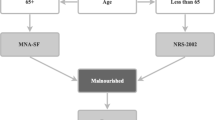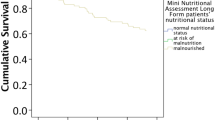Abstract
Objective: To assess the risk of malnutrition among elderly people living at home and receiving regular home-care services using the Mini-Nutritional Assessment (MNA) and to study the characteristics of the instrument in this patient group.
Design: A cross-sectional study using the MNA score to assess the nutritional status of elderly home-care patients.
Setting: Municipal home-care services in rural Finland.
Subjects: A total of 178 (65%) out of 272 eligible patients aged 75–94 y agreed to participate.
Major outcome methods: MNA questionnaire, anthropometrics, structured questionnaire, menu record.
Results: According to MNA, 3% were malnourished (MNA < 17 points), 48% at risk for malnutrition (17–23.5 points) and 49% well nourished (>23.5 points). The mean MNA score was 23.4. Weight loss, psychological stress, nutritional status, decline in food intake, self-perceived health status and mid-arm circumference (MAC) showed the strongest significant correlations (P=0.0001) to total MNA score. MNA questions with the strongest significant intercorrelations (P=0.0001) were body mass index with MAC and calf circumference; and the decline of food intake and self-perceived nutritional status. The number of eating problems correlated significantly to the MNA score (P=0.0011). Those with chewing and swallowing problems (n=64, 36%) had a significantly lower MNA score than others (P=0.0001). Dry mouth together with chewing and swallowing problems (n=40, 22%) reduced the MNA score even further (P=0.0001).
Conclusions: The results suggest that MNA is a useful tool in the identification of elderly home-care patients at risk for malnutrition.
This is a preview of subscription content, access via your institution
Access options
Subscribe to this journal
Receive 12 print issues and online access
$259.00 per year
only $21.58 per issue
Buy this article
- Purchase on Springer Link
- Instant access to full article PDF
Prices may be subject to local taxes which are calculated during checkout
Similar content being viewed by others
References
Axen K & Schnoll R (1995): Nutritional issues in the frail older person. Top. Geriatr. Rehabjil. 11, 1–10.
Beck AM, Ovesen L & Schroll M (2001): A six months' prospective follow-up of 65+-y-old patients from general practice classified according to nutritional risk by the Mini Nutritional Assessment. Eur. J. Clin. Nutr. 55, 1028–1033.
Christensson L, Unosson M & Ek A-C (2002): Evaluation of nutritional assessment techniques in elderly people newly admitted to municipal care. Eur. J. Clin. Nutr. 56, 810–818.
Chumlea WC, Roche AF & Steinbaugh ML (1985): Estimating stature from knee height for persons 60 to 90 years of age. J. Am. Geriatr. Soc. 33, 116–120.
Dey DK, Rothenberg E, Sundh V, Bosaeus I & Steen B (2001): Body mass index, weight change and mortality in the elderly. A 15 y longitudinal population study of 70 y olds. Eur. J. Clin. Nutr. 55, 482–492.
Government Advisory Committee for Nutrition (Valtion ravitsemusneuvottelukunta) (1998): Finnish Nutrition Recommendations. Helsinki: Edita (in Finnish).
Griep MI, Mets TF, Collys K, Ponjaert-Kristoffersen I & Massart DL (2000): Risk of malnutrition in retirement homes elderly persons measured by the “Mini-Nutritional Assessment”. J. Gerontol. Med. Sci. 55A, M57–M63.
Guigoz Y, Vellas B & Garry P (1996): Assessing the nutritional status of the elderly: the Mini Nutritional Assessment as part of the geriatric evaluation. Nutr. Rev. 54 (Suppl 2), 59–65.
Lahti-Koski M & Kilkkinen A (2001): Nutrition Report 2000 (Ravitsemuskertomus 2000). (English summary). Helsinki: Publications of the National Public Health Institute B1/2001.
Lamy M, Mojon P, Kalykakis G, Legrand R & Butz-Jorgensen E (1999): Oral status and nutrition in the institutionalised elderly. J. Dent. 27, 443–448.
McCormack P (1997): Undernutrition in the elderly population living at home in the community: a review of the literature. J. Adv. Nurs. 26, 856–863.
McGee M & Jensen G (2000): Nutrition in the elderly. J. Clin. Gastroenterol. 30, 372–380.
Mowé M, Bohmer T & Kindt E (1994): Reduced nutritional status in an elderly population (>70 y) is probable before disease and possibly contributes to the development of disease. Am. J. Clin. Nutr. 59, 317–324.
Murphy MC, Brooks CN, New SA & Lumbers ML (2000): The use of the Mini-Nutritional Assessment (MNA) tool in elderly orthopaedic patients. Eur. J. Clin. Nutr. 54, 555–562.
National Public Health Institute (1998): The 1997 Dietary Survey of Finnish Adults. Helsinki B8/1998, Finland.
Närhi TO (1994): Salivary findings in the elderly. Thesis, University of Helsinki, Finland.
Närhi TO, Meurman JH, Ainamo A, Nevalainen MJ, Schmidt-Kaunisaho K-G, Siukonsaari P, Valvanne J, Erkinjuntti T, Tilvis R & Mäkilä E (1992): Association between salivary flow rate and the use of systemic medication among 76-, 81-, and 86-year-old inhabitants in Helsinki, Finland. J. Dent. Res. 71, 1875–1880.
Pietinen P, Lahti-Koski M, Vartiainen E & Puska P (2001): Nutrition and cardiovascular disease in Finland since the early 1970s: a success story. J. Nutr. Health Aging 5, 150–154.
Reuben DB, Greendale GA & Harrison GG (1995): Nutrition screening in older persons. J. Am. Geriat. Soc. 43, 415–425.
Rivière S, Gillette-Guyonnet S, Nourhashemi F & Vellas B (1999): Nutrition and Alzheimer's disease. Nutr. Rev. 57, 363–367.
Rissanen PM, Laakkonen EI, Suntioinen S, Penttilä IM & Uusitupa MI (1996): The nutritional status of Finnish home-living elderly people and the relationship between energy intake and chronic diseases. Age Ageing 25, 133–138.
Rubenstein LZ, Harker JO, Salva A, Guigoz Y & Vellas B (2001): Screening for undernutrition in geriatric practice: developing the Short-Form Mini Nutritional Assessment (MNA-SF). J. Gerontol. Med. Sci. 56A, M366–M372.
Saletti A, Johansson L & Cederholm T (1999): Mini-Nutritional Assessment in elderly subjects receiving home nursing care. J. Hum. Nutr. Dietet. 12, 381–387.
Schneider SM & Hebuterne X (2000): Use of nutritional scores to predict clinical outcomes in chronic diseases. Nutr. Rev. 58, 31–38.
Sharkey JR (2002): The interrelationship of nutritional risk factors, indicators of nutritional risk, and severity of disability among home-delivered meal participants. Gerontologist 42, 373–380.
Sulander T, Helakorpi S, Nissinen A & Uutela A (2001): Health Behaviour and Health Among Finnish Elderly, Spring 2001, with Trends 1993–2001 (English summary). Helsinki: Publications of the National Public Health Institute B17/2001, Finland.
Sullivan DH (1992): Risk factors for early hospital readmission in a select population of geriatric rehabilitation patients: the significance of nutritional status. J. Am. Geriatr. Soc. 40, 792–798.
Tierney A (1996): Undernutrition and elderly hospital patients: a review. J. Adv. Nurs. 23, 228–236.
Thomas DR, Zdrowski CD, Wilson M-M, Conright KC, Lewis C, Tariq S & Morley JE (2002): Malnutrition in subacute care. Am. J. Clin. Nutr. 75, 308–313.
Vellas B, Guigoz Y, Garry P, Nourhashemi F, Bennahum D, Laque S & Albadere J-L (1999): The Mini Nutritional Assessment (MNA) and its use in grading the nutritional state of elderly patients. Nutrition 15, 116–122.
White H, Pieper C, Schmader K & Fillenbaum G (1996): Weight change in Alzheimer's disease. J. Am. Geriatr. Soc. 44, 265–272.
WHO (2002): Active Ageing: A Policy Framework. Geneva. www.who.int/hpr/ageing/ActiveAgeingPolicyFrame.pdf
Willett W (1998): Nutritional Epidemiology, 2nd edition. New York: Oxford University Press.
Wissing U, Lennernäs A-C, Ek A-C & Unosson M (1998): Monitoring of dietary quality in outpatients by qualitative meal classification method. J. Hum. Nutr. Dietet. 11, 125–133.
Author information
Authors and Affiliations
Contributions
Guarantor: H Soini.
Contributors: HS designed the study, organised the project, analyed and interpreted the data, drafted and finalised the manuscript; PR, PhD, supervised the study, assisted in analysing the data, critically revised the article and contributed to the final approval of the article; HL, PhD, assisted in designing the study, critically revised the article and contributed to the final approval of the article.
Corresponding author
Rights and permissions
About this article
Cite this article
Soini, H., Routasalo, P. & Lagström, H. Characteristics of the Mini-Nutritional Assessment in elderly home-care patients. Eur J Clin Nutr 58, 64–70 (2004). https://doi.org/10.1038/sj.ejcn.1601748
Received:
Revised:
Accepted:
Published:
Issue Date:
DOI: https://doi.org/10.1038/sj.ejcn.1601748
Keywords
This article is cited by
-
Dietary fat intake and quality in long-term care residents in two cohorts assessed 10 years apart
BMC Nutrition (2022)
-
Comparing the validity of anthropometric measurements in identifying malnutrition status of older age people in Borena district, North Central Ethiopia: a cross_sectional study
BMC Geriatrics (2022)
-
Effect of individually tailored nutritional counselling on protein and energy intake among older people receiving home care at risk of or having malnutrition: a non-randomised intervention study
BMC Geriatrics (2022)
-
Nutritional profiles of older adults according the Mini-Nutritional Assessment
Aging Clinical and Experimental Research (2020)
-
Change in quality of life and potentially associated factors in patients receiving home-based primary care: a prospective cohort study
BMC Geriatrics (2019)



